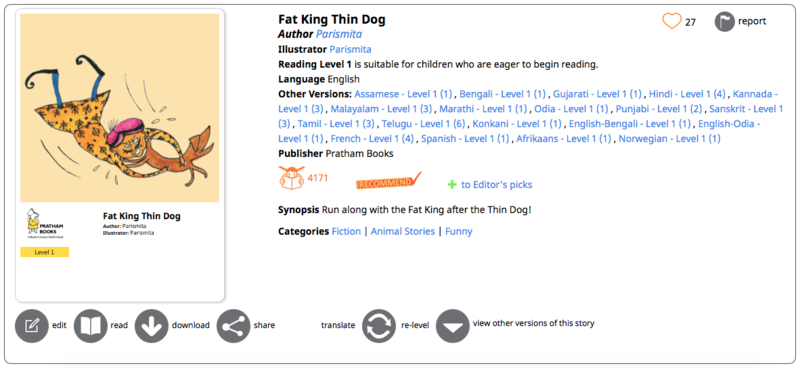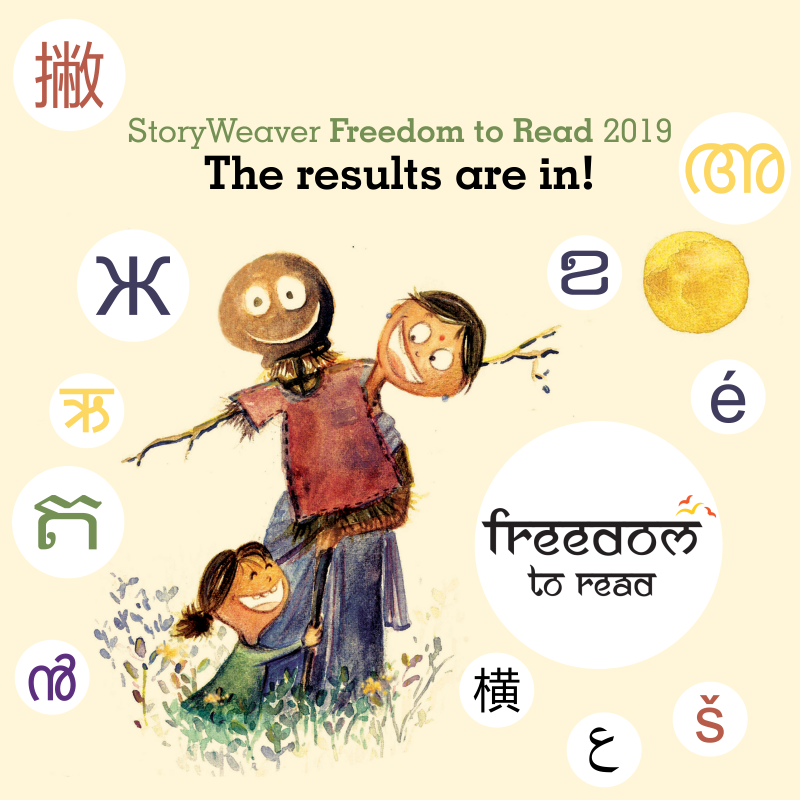News You Can Use! 'Other Versions' of a story!
Posted by Remya Padmadas on March 04, 2016Did you know that you can now see how many versions of a story there are on StoryWeaver upfront?
When you click on the 'read' icon of a story you'll be directed to a page that has all the information you need to know about that story. We've added Other Versions to this page. Here, at a galnce, you can see how many languages the story has been translated in to and how many translations there are of a story in a particular language!

However, just because a version of a story already exists in a particular language, don't let that deter you frome trying your hand at translating it yourself. StoryWeaver believes in and encourages as many diverse re-tellings of a story as possible!
comment (1)StoryWeaver at 5 conferences!
Posted by Pallavi Krishnan on February 25, 2019written by Anamika Radhakrishnan, Arpit Arora, Pallavi Krishnan
The StoryWeaver team has been attending a number of conferences in the last few months. Here’s a look at the highlights from some of them.
DataKind Bangalore, DataLearn "Data Matters" (Nov, 2018)
Pratham Books was invited to talk about the advantages of a data-driven approach in developing the StoryWeaver platform and showcase the project with DataKind Bangalore to develop a NLP prototype to auto-tag stories with relevant keywords and themes to enhance content discoverability.
Arpit Arora from StoryWeaver was also a panelist at the event talking about the importance of data-driven strategies at social organisations and how other organisations and volunteers emulate this approach.
International Conference on Technology for Education 2018 (Dec, 2018)
Pratham Books was recently part of the International Conference on Technology for Education (T4E 2018) held at the Indian Institute of Technology Madras, Chennai. This was the ninth in a series of annual events held with the objective to bring together all colleagues interested in promoting learning and teaching through the use of information and communication technology (ICT).
Anamika Radhakrishnan from the StoryWeaver team talked about “Leveraging technology, collaboration and open content to address the global book drought for children”. The 20 minute presentation was followed by an extremely interesting Q&A on how AI can help address many of the challenges faced by the StoryWeaver platform
Microsoft Academic Research Summit, IIT Madras (Jan, 2019)
Purvi Shah, Digital Head, StoryWeaver was was invited by Microsoft Research to talk on the topic of AI for Societal Impact and how StoryWeaver plans to leverage AI to move towards its mission of ‘A book in every child’s hand’. The summit was a forum to foster meaningful discussion and discussion among the Indian Computer Science research community and enable collaborations to advance the state of the art and raise the bar on research efforts. The theme for this years summit was Data Science and AI.
This comes shortly after the commencement of our partnership with Microsoft Research to develop Parallel Corpuses for improving the efficacy of crowd sourced Indic language translations.
AXLE 2019 (Jan 2019)
Pratham Books was invited to be part of a panel discussion at AXLE 2019 held by Microsoft Academia Accelerator at Bengaluru. The panel discussion titled Building and Using Technology for Underserved Languages included discussions around how English is currently the aspirational language. Anamika Radhakrishnan from the StoryWeaver team says “It was extremely gratifying to know that preserving our mother tongue languages is given a high priority across sectors including the mainstream technology companies such as Microsoft”
Bodh: EdTech roundtable for social impact: Tata Communications (Feb, 2019)
Under the aegis of Kreeda aur Shiksha, a Tata Communications - VVMVP Initiative, BODH: A Roundtable on EdTech for Social Impact was held in Bengaluru. The idea of the BODH roundtable is to create a space for informed conversations on EdTech and bring together innovators and practitioners who are transforming learning in formal and non-formal spaces using ICTs and new media. There were over 28 speakers who contributed to the roundtable.
Pratham Books was asked to participate in a panel discussion at the session on Creating Impact Using Digital Media on the topic of Bridging the Gaps with Technology. Pallavi Krishnan from the StoryWeaver team was part of the panel discussion along with Smriti Reha from Anaadi Foundation and Vatsala Shrivastava from Social Alpha and was chaired by Supriya Singh from Tata Communications. The session focused on how practices from diverse fields have successfully channelized the potential of digital and new media to create social impact.
Update: StoryWeaver Freedom to Read 2019
Posted by Amna Singh on December 27, 2018Written by Amna Singh
StoryWeaver believes that every child deserves to have access to joyful reading material in her mother tongue. In November 2018, we opened applications to educators, translators, literacy organisations, and everyone else working with children to promote reading -- in our quest for partners to help build a 100 local language libraries of children’s books in underserved languages by International Mother Language Day on February 21, 2019 .
We were seeking partners with relevance of work and expertise in language and translations, and above all, a shared vision of equity in access for all. We got over 225 applications from all over the globe – each application inspiring us with their exemplar work in the field of literacy and language for the under-represented communities.
Based on our guidelines, relevance of work and a rigorous evaluation, we have selected 16 organisations and 28 individual language champions to partner with us to build these digital local libraries.
Selected Organisations: Target Languages
-
Azad India Foundation: Surjapuri
-
BookDash: 11 official South African languages
-
SNS Foundation: Marwari
-
CODE- Ethiopia: Amharic, Afaan Oromoo
-
African Library and Information Associations and Institutions (AfLIA): Igbo, Hausa, Fante, Ewe, Yoruba, Kikiyu, Luganda and Swahili
-
Global Forum 4 Literacy: Zulu, Afrikaans, Xhosa, Tswana and Arabic
-
Suchana Uttor Chandipur Community Society: Santali, Kora, Bilinguals
-
Aripana Foundation: Maithili
-
Little Readers' Nook: Tulu, Kutchi, Marwari …
-
Unnati Institute for Social and Educational Change: Korku
-
North East Educational Trust: Assamese, Bodo
-
Brightstart Pre Primary school and Learning Centre : Marwari
-
Libreo.ph: Tagalog, Cebuano, Hiligaynon, Tausug/Maranao and Ilokano
-
Darakht-e Danesh Library: Pashto
-
Every English: Brazilian Portuguese
-
REHMA: English-Urdu bilinguals
The selected language champions will help build local libraries across 24 languages.
Target Languages: Selected Language Champions:
-
Amharic: Kaleab
-
Bambara: Kirsty Paxton
-
Basa Jawa (Javanese): Maharani Aulia
-
Bundelkhandi: Ankit Dwivedi, Krishna Murary Upadhyay
-
Chinyanja: Agnes Nankhoma Singine Nyendwa
-
Dari: Aisha
-
Filipino: Kaye
-
Garhwali: Shweta Rawat
-
GSB Konkani: Sujith Kamath
-
Kirundi: Melchiade Ntibazonkiza, Adolphe Ndagijimana
-
Kui: Shruti
-
Kumaoni: Somya Budhori , Richa Pathak Pant,
-
Kuvi/Jatapu: Markose K C
-
Malay: David Loiuson
-
Malvani: Rupali Bodekar
-
Malvi: Omprakash Kshatriya
-
Ndebele: Ntando Titus Ntaka
-
Pawari: Amit Dudave
-
Pashto: Nighat Kamdar
-
Sanskrit: Meenakshi Sundaram K B, Priya Bhakthan
-
Serbian: Ana Jovic
-
Sindhi (Devanagari Script): Bharti
-
Sindhi (Arabic Script): Zaib-un-Nisa
-
Vietnamese: Nguyen Dac Thai Hang
Thank you for your initiative, we will get in touch with all selected partners for the next steps.
And a BIG thank you to everyone who applied. StoryWeaver is truly a result of your constant support, and contributions. We will do our best to reach out to you and explore alternate ways to collaborate. Thank you, again, and happy holidays!